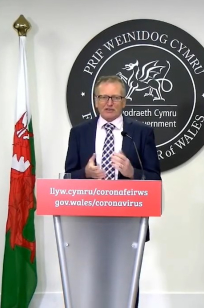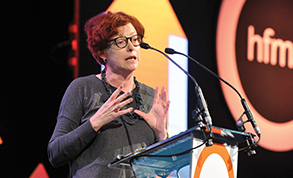Covid-19 update: 11 December
Health secretary Matt Hancock said the arrival of the Pfizer/BioNTech vaccine marked the ‘beginning of the end’ of the pandemic. First in the queue, following a Joint Committee on Vaccination and Immunisation (JCVI) prioritisation list, were over 80s, care home staff and NHS frontliners. Care home residents, who are in theory top of the list, will have to wait while logistical difficulties relating to the transporting and storage of vaccine can be overcome.
(The vaccine needs to be transported initially in packs of nearly 1,000 doses kept at minus 70 degrees Celsius and can only be moved four times within this cold chain. Currently this restricts the administering of the vaccines to specially designated hospital hubs. Work is still being done to understand how large packs could be broken up and the vaccine taken to care homes, rather than requiring care home residents to come to the vaccine.)
National medical director Stephen Powis described the process as a ‘complex and difficult logistical challenge’. However, he underlined the NHS’s ‘strong record of delivering large scale vaccination programmes – from the flu jab, HPV vaccine and lifesaving MMR jabs’. The complexities do not stop with the simple handling of the vaccine, which comes five doses to a vial and needs to be diluted with room temperature saline before use. GPs stand ready to staff 1,000 local vaccination centres, which will be switched on as vaccine becomes available.
Once GPs are told when this will commence, they will have to rapidly contact their vulnerable populations to offer appointments. Some areas may have to reach outside the top priority cohort to ensure vaccine isn’t wasted. And there are issues around how the consent process might be speeded up to ensure bureaucracy, however important, doesn’t stop needles getting to arms as fast as safely possible.
The validity of the JCVI prioritisation was brought home this week by statistics showing how deaths could have been impacted if a vaccine had been available at the outset of the pandemic. Stuart MacDonald, a fellow at the Institute and Faculty of Actuaries in the UK, has analysed how the Covid-19 deaths to date are distributed across the JCVI’s nine priority groups. With more than 60,000 deaths to date, he found that about 23,000 or 36% of the total deaths were in the JCVI top priority group (care home residents and their carers). This includes both those who died in care homes and those who died in hospital but normally resided in care homes.
He told BBC Radio 4’s More or less podcast that about 500,000 people lived in care homes and 23,000 represented a big proportion of the care home community. So vaccinating less than 1% of the population could potentially prevent more than one third of the deaths due to Covid. He then looked at the next category, estimating there were about five million over 80-year-olds and frontline healthcare workers. There have been around 19,000 deaths in this group (with very small numbers in overall terms among healthcare workers) – around 30% of all deaths. Taken together he said this meant that vaccinating just 10% of the population could potentially prevent two thirds of all deaths.
More than half the population fell into the bracket of being under 50 without an underlying health condition, and there had been fewer than 800 deaths in this group to date – 1% of all deaths.
Oxford results
Meanwhile, the Oxford vaccine is hot on the heels of its Pfizer/BioNTech ‘rival’. The Oxford offering, which is being produced by AstraZeneca, became the first to have its trial efficacy results published in a scientific paper. The paper, published in The Lancet, confirmed an overall vaccine efficacy of just over 70%. Final approval of the Oxford vaccine may be what enables vaccinations to get underway in care homes, given the less complex storage and transport requirements.
While the news on vaccines is positive, the country still faces a tough winter. With the vaccines requiring two doses, it can take around a month from the first injection before the protection is at its strongest. The vaccination of all vulnerable groups will stretch well into the new year, so social distancing measures still have a significant part to play in minimising further deaths and hospital admissions.
An acceleration of coronavirus infections in Wales underlined concerns that the NHS could still be overwhelmed. Chief medical officer Frank Atherton (pictured) told a government press briefing that Wales was in a ‘very serious situation’ with the nation’s infection rate hitting 350 cases for every 100,000 people – the highest rate across the four UK nations. In 10 local authority areas, the rate is higher than 400 per 100,000.
‘Coronavirus infection is spreading and spreading fast. It is accelerating across the country,’ he said. ‘That is happening more quickly than we anticipated as we came out of the firebreak just a few weeks ago and it is accelerating at a greater speed than we have seen during the autumn months.’
The rising cases are already hitting the health service. Dr Atherton said there were serious pressures on the NHS across Wales but particularly in the south. This was being felt in hospitals, in the ambulance service, but particularly in intensive care units, where staff were working flat out.
There were more than 1,800 coronavirus patients in hospital across Wales and with patients typically in hospital for up to three weeks, this put pressure on occupancy.
Difficult position
Hywel Dda University Health Board was one of boards declaring itself to be in a ‘very difficult position’. In a statement it said it was not able to safely staff all of the beds it would hope to have open at this point in the year. And it has also had to transfer some staff and patients to field hospitals in Carmarthenshire and Pembrokeshire.
The board called for the public’s help. 999 should be reserved for urgent and emergency care only. For non-urgent care, alternatives to accident and emergency should be used. And where patients in hospital had tested negative and were fit for discharge, families could help by supporting discharge to home. Beyond that, the board called for people to follow the government guidance.
‘It is critical for the public to understand that we are still at a very dangerous point in the cycle of the pandemic and there is still some way to go before we can return to normality,’ said Andrew Carruthers, the board’s director of operations. ‘We are dealing with significantly more cases of Covid-19 in our hospitals than we previously had in the spring. Unfortunately, this has also affected our workforce and severely hampered our capacity and escalation plans.’
The hospitals would ‘get through this’, but onward transmission needed to be stopped and the workforce given a chance to recover.
Welsh NHS Confederation director Darren Hughes said the impacts were being felt right across the health and care system and affecting the capacity to treat other significant health issues. ‘As a consequence of increased transmission rates, more staff are at risk of contracting the virus or having to self-isolate because others in their household have symptoms,’ he said. ‘Staff are really feeling the effects of this across Wales. They are working flat out to give patients the very best care they can.’
While he said the first vaccine clinics were a positive development, ‘the vaccine does not mean the pandemic is over and that we can go back to business as usual’. He urged the public to ‘think carefully about what we should do, rather than what we can do’.
Tracing improvement
This week’s NHS Test and Trace report revealed that 1.6 million people were tested in the week to 2 December, with more than 96,000 testing positive. Just under 92,000 people were transferred to the contact tracing system and nearly 79,000 of these were reached. Some 60,000 of these provided details of 195,000 close contacts. Taking into account all contacts identified, 86% were reached. Although this is a big increase on previous weeks, it benefits from changes in recent weeks enabling a household to be traced by a single phone call, rather than everyone being contacted separately.
Saffron Cordery, NHS Providers deputy chief executive, said the testing figures were moving in the right direction, but turnaround times for pillar 2 test results were still relatively slow. There was no room for complacency. ‘We have to keep abiding by the restrictions to keep preventing the spread of Covid-19,’ she said.
However the improvement coincided with a new National Audit Office report looking at The government’s approach to test and trace in England that highlighted the failings in the delivery of the service to date.
The report – an interim publication ahead of an examination of the value for money of the service next spring – said no business case had documented the chosen outsourced business model for tracing, a model that is unusual in international comparisons. While government set targets for testing capacity were reached, actual testing levels had been well below these levels. Between May and October, on average the number of tests carried out was only 68% of the published maximum.
Despite a target to provide results within 24 hours of in-person testing, this was only being met in 14% of cases in mid-October, before rising to 38% in early November. And while NHS Test and Trace got to the point of contacting 85% of those who had tested positive, at the end of October it was still only reaching 60% of their close contacts.
The report also highlighted how, at times, parts of the national tracing service have barely been used. The utilisation rate in June for health professionals and call handing staff was 4% and 1% respectively, indicating they had little work to do. The Department of Health and Social Care had no flexibility to reduce staff numbers under the original three-month contracts and even after it negotiated new terms in August and reduced staff numbers, utilisation rates remained well below a target of 50% throughout September and much of October.
 Head of the NAO Gareth Davies (pictured) acknowledged that the government had rapidly increased testing and tracing activity, building new infrastructure and capacity from scratch. ‘However, it has struggled to test and trace as many people as it has capacity to, or to reach the contacts of people testing positive quickly enough,’ he said. ‘Test and Trace is core to the UK’s pandemic response. It must improve its performance with a focus on effective engagement with the public and integration with local efforts to improve tracing.’
Head of the NAO Gareth Davies (pictured) acknowledged that the government had rapidly increased testing and tracing activity, building new infrastructure and capacity from scratch. ‘However, it has struggled to test and trace as many people as it has capacity to, or to reach the contacts of people testing positive quickly enough,’ he said. ‘Test and Trace is core to the UK’s pandemic response. It must improve its performance with a focus on effective engagement with the public and integration with local efforts to improve tracing.’
As the week drew to a close, the country was given a final reminder of the delicate position the NHS was in. Even without ongoing Covid activity, it would face a significant challenge to recover. At the end of October there were 4.4 million patients waiting to start treatment, with nearly 163,000 waiting more than a year .
Layla McCay, NHS Confederation director, described the scale of the challenge as ‘gargantuan’. She praised the service for the work it had done towards recovery during the summer. ‘But with a brand new mass vaccination programme to deliver, the need to provide Covid-19 related care across the NHS from acute hospitals to community services, and with more than 160,000 patients now waiting over a year for treatment as of the end of October, all in addition to routine care, it is clear just how much additional pressure the pandemic has heaped onto the service.’
She said that this week’s announcements on hospital improvements needed to be matched with greater investment in people to fill the 87,000 vacancies across the NHS.
Nursing warning
A report from The Health Foundation this week focused on nursing shortages. Building the NHS nursing workforce in England claimed that increases in nurse numbers in recent years were likely to be insufficient in the face of growing demand. And this demand had been increased further by the pandemic. While the government’s target of 50,000 nurses was achievable, it may still leave key service areas well short of the numbers needed.
 Community, mental health and learning disability nurses were a particular concern, with numbers dropping in the last decade, despite nurse numbers increasing overall. ‘Nine months into the pandemic, the nursing workforce is under incredible strain,’ said director of research Anita Charlesworth (pictured). ‘One in 10 nursing posts are vacant, and absence rates remain high. Our analysis shows that although nursing numbers are going up overall, in some areas they are lower than they were 10 years ago. This is hugely concerning as we are now in a situation where the number of people waiting for routine elective care exceeds 4 million and there is growing demand for mental health services.’
Community, mental health and learning disability nurses were a particular concern, with numbers dropping in the last decade, despite nurse numbers increasing overall. ‘Nine months into the pandemic, the nursing workforce is under incredible strain,’ said director of research Anita Charlesworth (pictured). ‘One in 10 nursing posts are vacant, and absence rates remain high. Our analysis shows that although nursing numbers are going up overall, in some areas they are lower than they were 10 years ago. This is hugely concerning as we are now in a situation where the number of people waiting for routine elective care exceeds 4 million and there is growing demand for mental health services.’
Back on the performance figures, Nuffield Trust deputy director of research Sarah Scobie warned that the numbers on the waiting list could be just the tip of the iceberg. ‘In November, we saw a fall in the number of people seeking emergency care from hospital A&E departments,’ she said. ‘We have seen these numbers steadily decline by 14% since August, and they are far below levels we’d expect to see during the early winter months.’
Some of this could be due to people calling 111 instead of turning up at A&E, but the fear of catching the virus could also be deterring people.
‘The NHS this week became the first western health system to begin roll-out the first Covid-19 vaccine – a huge step forward in protecting people from the virus,’ she said. ‘But as the pandemic continues to drive up waiting times and puts people off addressing health concerns early, the service will be feeling the effects for quite some time.”
Nursing shortages comment/news/risk-to-pandemic-recovery-due-to-nursing-
Related content
We are excited to bring you a fun packed Eastern Branch Conference in 2025 over three days.
This event is for those that will benefit from an overview of costing in the NHS or those new to costing and will cover why we cost and the processes.